The Coming of Conan Re-Read: “The Devil in Iron”
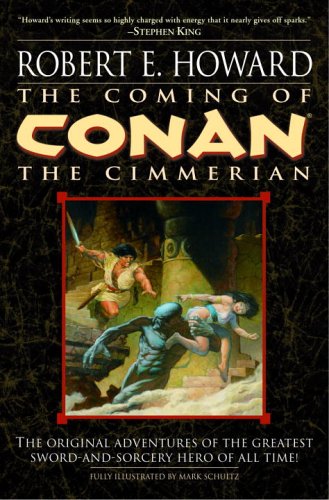 Bill Ward and I are finishing our read through of the Del Rey Robert E. Howard collection The Coming of Conan. This week we’re discussing “The Devil in Iron.” We hope you’ll join in!
Bill Ward and I are finishing our read through of the Del Rey Robert E. Howard collection The Coming of Conan. This week we’re discussing “The Devil in Iron.” We hope you’ll join in!
Bill: One thing that struck me as fresh with “The Devil In Iron,” a story that reprises many familiar elements from the last handful of Conan stories, is that an antagonist’s plan to kill Conan is what sets the plot in motion. We haven’t seen that in a story since “The Phoenix on the Sword” and “The Scarlet Citadel,” two King Conan yarns where his importance to the larger Hyborian world is undeniable.
Howard: I ended up liking this one more than I was afraid I was, because I’d recalled that it was sort of a fix-up of elements we’d seen before. I do wish we saw more of Conan being a Kozak and having Kozak adventures, but, alas, we only hear about it and see his outfit.
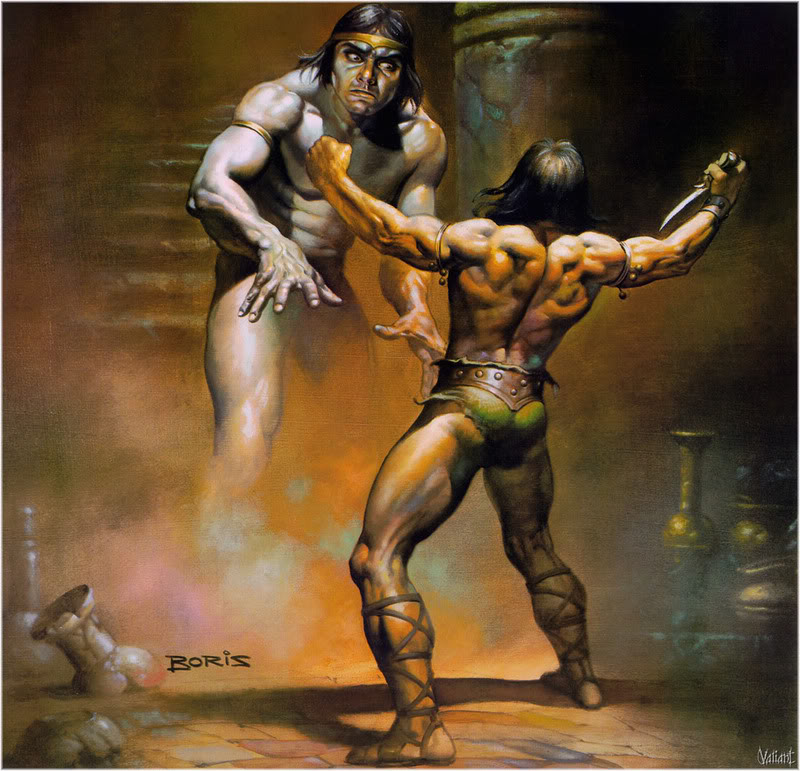 Harold Lamb was one of Robert E. Howard’s favorite writers and you can see his influence upon Howard, most especially in his historicals (I wrote about this extensively in the concluding essay in the Del Rey historical volume of Robert E. Howard fiction, Sword Woman). But you usually don’t see Lamb influence in the Conan stories… except for here. Did you notice the word “shagreen?” It hasn’t appeared in any Conan stories until this one, where it crops up at least three times. It’s a word Lamb employed to describe a kind of boot texture his Cossack characters wore.
Harold Lamb was one of Robert E. Howard’s favorite writers and you can see his influence upon Howard, most especially in his historicals (I wrote about this extensively in the concluding essay in the Del Rey historical volume of Robert E. Howard fiction, Sword Woman). But you usually don’t see Lamb influence in the Conan stories… except for here. Did you notice the word “shagreen?” It hasn’t appeared in any Conan stories until this one, where it crops up at least three times. It’s a word Lamb employed to describe a kind of boot texture his Cossack characters wore.
Note also the name Jehungir and, of course, the word kozak, and the description of the kozak camp on the river and other cossack terminology. All of these are likely, though not definitively, from Lamb (Howard might have been reading about Cossacks and an emperor named Jehangir from other source, although both were beloved by Lamb). It’s rather a superficial influence compared to some of that found in the historicals, but it’s there.
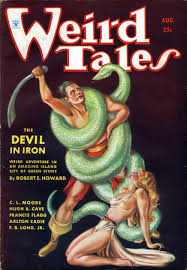 Bill: Very cool, I hadn’t made the connection but it’s obvious now. We’ve heard mention of Conan as a kozak in previous tales, but in “The Devil In Iron” Conan is actually the commander of the freebooters, and could be said to be a kind of king and an important player in the region of Hyrkania and Turan. In “The Scarlet Citadel” King Conan is trapped and captured because of a betrayal of alliances. In this story, pirate Conan is lured into a trap on a remote island in the Vilayet Sea, drawn there by the promise of a buxom beauty.
Bill: Very cool, I hadn’t made the connection but it’s obvious now. We’ve heard mention of Conan as a kozak in previous tales, but in “The Devil In Iron” Conan is actually the commander of the freebooters, and could be said to be a kind of king and an important player in the region of Hyrkania and Turan. In “The Scarlet Citadel” King Conan is trapped and captured because of a betrayal of alliances. In this story, pirate Conan is lured into a trap on a remote island in the Vilayet Sea, drawn there by the promise of a buxom beauty.
After an opening in which the supernatural juggernaut of the title is teased, we are treated to an outline of the plot to catch Conan on the very same island where we’ve just seen an ancient evil reborn. “The Devil in Iron” is heavily reminiscent of “Iron Shadows in the Moon” and “Xuthal of the Dusk,” but most especially the former of those two recent stories. Patrice Louinet, in his “Hyborian Genesis” essay at the back of The Coming of Conan, mentions the fairly large time gap between the writing of “The Vale of Lost Women” and this story, with “The Devil in Iron” serving as a way for REH to get back up to speed with the Cimmerian. The story is a fitting capstone to this collection of the first Conan tales, being one more of the ‘formula’ stories, but also one of the best of those.
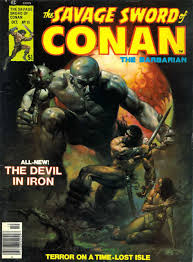 Howard: I think it’s definitely a tick up, even with some repeated themes. I thought that the history conveyed in a dream called back to “Queen of the Black Coast” and that the opening of the lone man awakening a powerful being of pre-history was similar to the opening to “Black Colossus.”
Howard: I think it’s definitely a tick up, even with some repeated themes. I thought that the history conveyed in a dream called back to “Queen of the Black Coast” and that the opening of the lone man awakening a powerful being of pre-history was similar to the opening to “Black Colossus.”
Bill: Absolutely, there is a lot of revisiting tried and true elements in this story. Like in “Iron Shadows,” here Conan explores the ruins of a mysterious island in the Vilayet Sea while a supernatural evil bides its time. But the ruins Conan finds on Xapur have been newly rebuilt, the entire city and its people reborn in the dream of an awakened demi-god from the dawn of time — and, as in “Xuthal,” which the story mentions directly in comparison, the city dreams its ancient dream at the whim of a malign master.
Howard: I liked that reference to Xuthal. It’s something we don’t often see in the Conan stories. It’s neat when Conan himself refers to things that have happened before.
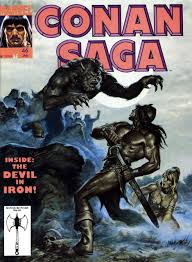 Bill: Me too, I was pleased to see it and would have liked to see more references like that between the stories. Despite recycling some elements, “Devil In Iron” works just fine as its own story, especially once we get all the set-up out of the way and Conan is tearing through the dreaming city with an indestructible god on his heels. In some ways many of those reused elements from other stories are used to better effect here — the “iron devil” himself, Khostal Kel, is much more interesting and integrated into the story than the “iron shadows” of a previous tale. The use of a special or magical weapon to defeat him is something I don’t think we’ve seen before, though it is of course a very common trope in modern fantasy.
Bill: Me too, I was pleased to see it and would have liked to see more references like that between the stories. Despite recycling some elements, “Devil In Iron” works just fine as its own story, especially once we get all the set-up out of the way and Conan is tearing through the dreaming city with an indestructible god on his heels. In some ways many of those reused elements from other stories are used to better effect here — the “iron devil” himself, Khostal Kel, is much more interesting and integrated into the story than the “iron shadows” of a previous tale. The use of a special or magical weapon to defeat him is something I don’t think we’ve seen before, though it is of course a very common trope in modern fantasy.
And while “The Devil In Iron” doesn’t give us too much in the way of REH’s barbarian versus civilization debate, it does posses some interesting elements and themes that tie in with it. One thing I noticed was that Conan was twice nearly overwhelmed by Khostal Kel’s strange visions of the past — and both times it was Octavia that pulled him out. Once it was her weeping that snapped the Cimmerian out of the black-lotus-like vision of the past that was destroying his sanity, and the second time it was her shouting in fear after Conan defeated the demi-god but was, again, in danger of losing his mind. Whether intentional or not, it certainly seems fitting that the very real charms of a lovely young woman, something as rooted in the reality of the physical self as is possible to be, is what drives the Lovecraftian madness away from our hero’s mind.
 Overall “The Devil In Iron” feels in some ways like the remix of a favorite song, it’s old familiar territory that’s well worth traipsing through again, and a welcome return to form after last week’s “The Vale of Lost Women.” From this point on the stories get much longer, the plots more involved, and REH’s inspirations shift in new directions. It’s a fitting place to end the first of Del Rey’s Conan collections, The Coming of Conan.
Overall “The Devil In Iron” feels in some ways like the remix of a favorite song, it’s old familiar territory that’s well worth traipsing through again, and a welcome return to form after last week’s “The Vale of Lost Women.” From this point on the stories get much longer, the plots more involved, and REH’s inspirations shift in new directions. It’s a fitting place to end the first of Del Rey’s Conan collections, The Coming of Conan.
Howard: All fairly said. Maybe it’s lighter Conan, but it’s still pretty tasty and delivers some fine moments.
Next week we’ll talk a little about what lies ahead and before too much longer we’ll plunge into the rest of the Conan stories, most of which, as Bill pointed out, are longer than what’s come before. Hope to see you here.
9 Comments